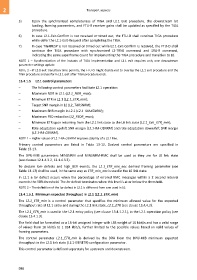Page 996 - 5G Basics - Core Network Aspects
P. 996
2 Transport aspects
5) Upon the synchronized completeness of TIGA and L2.1 Exit procedure, the downstream bit
loading, framing parameters, and FTU-R receiver gains shall be updated as specified by the TIGA
procedure.
6) In case L2.1-Exit-Confirm is not received or timed out, the FTU-O shall continue TIGA procedure
while defer the L2.1-Exit-Request after completing the TIGA.
7) In case TIGARESP is not received or timed out while L2.1-Exit-Confirm is received, the FTU-O shall
continue the TIGA procedure with synchronized L2-TRNS command and SRA-R command,
indicating the same superframe count for implementing the TIGA procedure and transition to L0.
NOTE 1 – Synchronization of the instants of TIGA implementation and L2.1 exit requires only one downstream
parameter settings update.
NOTE 2 – If L2.1 exit transition time permits, the FTU-O might decide not to overlap the L2.1 exit procedure and the
TIGA procedure and perform L2.1 exit after TIGA procedure ends.
13.4.1.5 L2.1 control parameters
– The following control parameters facilitate L2.1 operation:
– Maximum NDR in L2.1 (L2.1_NDR_max);
– Minimum ETR in L2.1 (L2.1_ETR_min);
– Target SNR margin in L2 (L2_TARSNRM);
– Maximum SNR margin in L2.1 (L2.1_MAXSNRM);
– Maximum PSD reduction (L2_PSDR_max);
– Minimum ETR upon returning from the L2.1 link state to the L0 link state (L2.1_Exit_ETR_min);
– Rate adaptation upshift SNR margin (L2.1-RA-USNRM) and rate adaptation downshift SNR margin
(L2.1-RA-DSNRM).
NOTE 1 – Higher values of L2.1-RA-USNRM improve stability of a L2.1 line.
Primary control parameters are listed in Table 13-12. Derived control parameters are specified in
Table 13-13.
The DPU-MIB parameters MINSNRM and MINSNRM-RMC shall be used as they are for L0 link state
(see clauses 12.1.4.3.2, 12.1.4.3.3).
To declare lom defects and high_BER events, the L2.1_ETR_min_eoc derived framing parameter (see
Table 13-13) shall be used, in the same way as ETR_min_eoc is used in the L0 link state.
In L2.1 a lor defect occurs when the percentage of errored RMC messages within a 2 second interval
exceeds the 50% threshold. The lor defect terminates when this level is at or below the threshold.
NOTE 2 – The definition of the lor defect in L2.1 is different from one used in L0.
13.4.1.5.1 Minimum expected throughput in L2.1 (L2.1_ETR_min)
The L2.1_ETR_min is a control parameter that specifies the minimum allowed value for the expected
throughput rate at L2.1 entry and during the L2.1 link state, L2.1_ETR (see clause 13.4.4.2).
The L2.1_ETR_min is used in the L2.1 entry policy (see clause 13.4.1.2.1), in the L2.1 operation policy (see
clause 13.4.1.3).
The field shall be formatted as a 16-bit unsigned integer with LSB weight of 16 kbit/s and has a valid range
of values from 16 kbit/s to 1 024 kbit/s, further limited to the possible values based on valid values of
framing parameters.
The control parameter L2.1_ETR_min is derived by the DRA from the DPU-MIB minimum expected
throughput in the L2.1 link state (L2.1-MINETR) configuration parameter.
This control parameter is defined separately for upstream and downstream.
986

